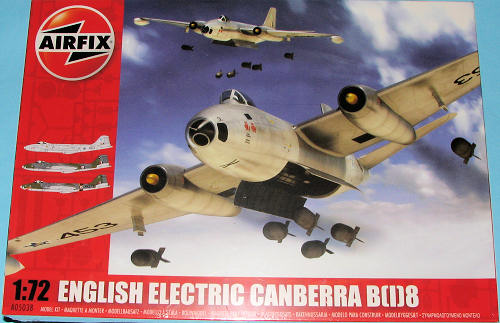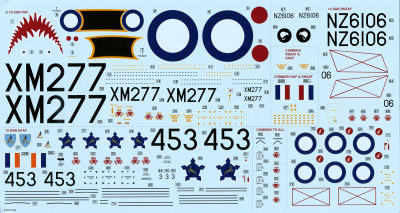
| KIT #: | A05038 |
| PRICE: | $21.95 MSRP |
| DECALS: | Three options |
| REVIEWER: | Scott Van Aken |
| NOTES: | New mold kit |

| HISTORY |
| THE KIT |
 I know that most of us were very pleased to hear that Airfix was going to produce a series of 1/48 Canberras and were hoping that these would be reduced to 1/72. Well that has been going on and the B(I).8 is the subject of their first release. Molded in the usual grey we have come to expect from Airfix, there are six grey and one clear sprue. The clear sprue has the canopy which was made as if it opened up like a jet fighter. I don't think this was the case as the instructions have a big X through an open canopy option.
I know that most of us were very pleased to hear that Airfix was going to produce a series of 1/48 Canberras and were hoping that these would be reduced to 1/72. Well that has been going on and the B(I).8 is the subject of their first release. Molded in the usual grey we have come to expect from Airfix, there are six grey and one clear sprue. The clear sprue has the canopy which was made as if it opened up like a jet fighter. I don't think this was the case as the instructions have a big X through an open canopy option.
 The panel lines are fine, though perhaps a tad large. One thing I did notice was a number of shallow sink areas opposite the alignment pins. This is most obvious on the wings so prepare for some filler work to level those out. The kit has a lot going for it. There is a full cockpit and nose interior section. Molding here is quite good and will satisfy most modelers. The seats even have belt detail molded in place. Crew figures are provided if you wish to use them. There are resin upgrades for those who want a bit more detail in this area. To keep it from tail sitting, you'll need to add 45 grams behind the cockpit section. This is quite a bit of weight for most models.
The panel lines are fine, though perhaps a tad large. One thing I did notice was a number of shallow sink areas opposite the alignment pins. This is most obvious on the wings so prepare for some filler work to level those out. The kit has a lot going for it. There is a full cockpit and nose interior section. Molding here is quite good and will satisfy most modelers. The seats even have belt detail molded in place. Crew figures are provided if you wish to use them. There are resin upgrades for those who want a bit more detail in this area. To keep it from tail sitting, you'll need to add 45 grams behind the cockpit section. This is quite a bit of weight for most models.
The kit has separate wheel well inserts as well as separate control surfaces. These control surfaces are curved are as the attaching points so you can model them deflected if you wish. One of my elevators was very badly warped and it will take some work to flatten it back out. You also have separate flap sections and can show those deployed as well. Landing gear are very nicely detailed with the proper thick doors and very positive attachment lugs. The doors have to be cut apart (a normal way to reduce molding expenses). Nose gear includes separate debris shields for each nose tire. The bomb bay can be built open or closed and if open then there are a quartet of bombs that can be installed. To use the gun pack, the bay doors need to be closed.
For the things under wings we start with the wing tip drop tanks. The wings already have holes opened for these, though the B(I).8 was often flown without them. For the rest of the wings there are up to four holes per wing that can be opened, though most planes will only have the outer three available. The instructions show which markings options have this feature. There are pylons for bombs, rocket pods (including a dual pod pylon) or missiles.
 Instructions are well done and have as the cover image, the box art from the 1/48 kit. All paints are Humbrol numbers only with no clue as to what the actual colors are. I'll repeat that this is a lame way of doing paint as not al modelers have access to Humbrol paints. A large full color painting and markings chart is provided, also only giving Humbrol paint
Instructions are well done and have as the cover image, the box art from the 1/48 kit. All paints are Humbrol numbers only with no clue as to what the actual colors are. I'll repeat that this is a lame way of doing paint as not al modelers have access to Humbrol paints. A large full color painting and markings chart is provided, also only giving Humbrol paint numbers. There are three schemes available. One is an RAF 16 Squadron plane from 1972 in the Green/Grey/Aluminum finish. Also in this finish is a New Zealand 14 Squadron plane from 1968. The third option is an overall aluminum painted plane from 12 Squadron, South African Air Force. This aircraft has yellow engine intake bullets. The decal sheet provides all the markings and data information. It is superbly printed and as good looking as any aftermarket sheet. I'm sure this is a result of Hornby's take-over of the company as one thing Hornby does well is to improve what it buys.
numbers. There are three schemes available. One is an RAF 16 Squadron plane from 1972 in the Green/Grey/Aluminum finish. Also in this finish is a New Zealand 14 Squadron plane from 1968. The third option is an overall aluminum painted plane from 12 Squadron, South African Air Force. This aircraft has yellow engine intake bullets. The decal sheet provides all the markings and data information. It is superbly printed and as good looking as any aftermarket sheet. I'm sure this is a result of Hornby's take-over of the company as one thing Hornby does well is to improve what it buys.
| CONCLUSIONS |
If you like Canberras, toss your Frog kit to the kids and pick this one up. Best of all is that it isn't $60, but a super reasonable price so you have NO excuse!
| REFERENCES |
Thanks to me for being willing to lay out the loot for this one.
January 2010
If you would like your product reviewed fairly and fairly quickly, please contact the editor or see other details in the Note to Contributors.